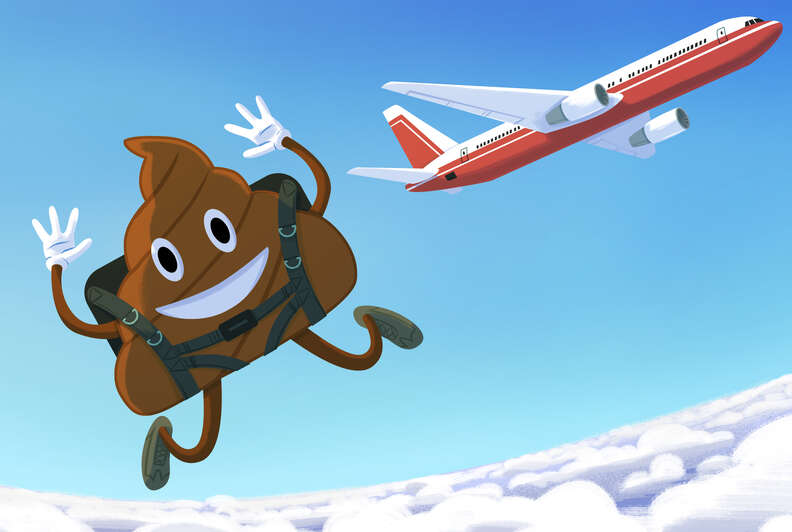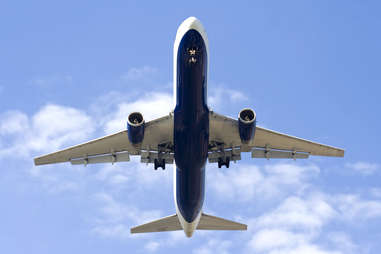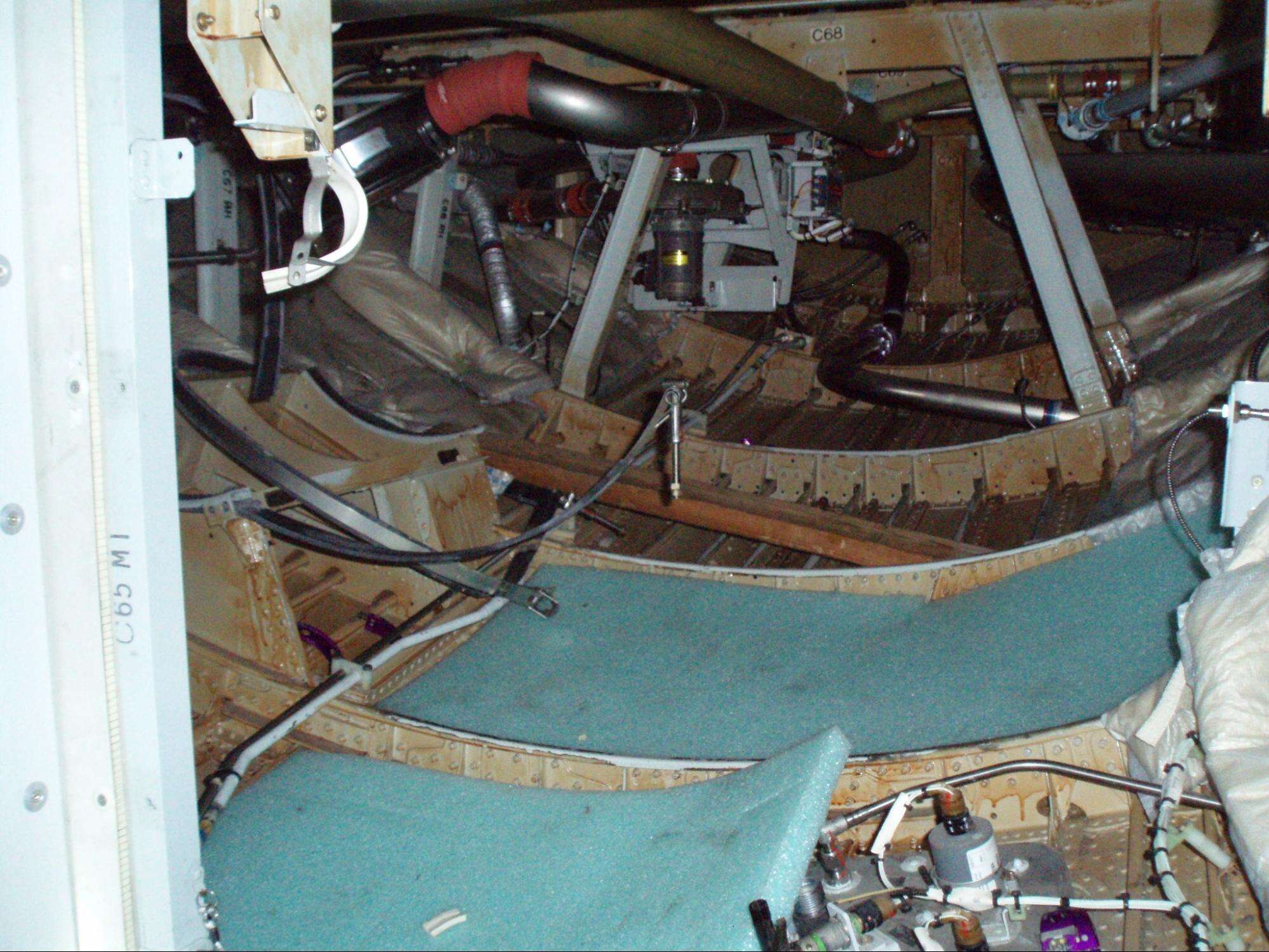How Airplane Toilets (Mostly) Stopped Dropping Frozen Sewage From the Sky

On a balmy Thursday in February 2012, Artie Hughes and his wife were on the deck of their Long Island home, enjoying a spot of unseasonably warm weather. The early-evening calm had a palpable effect, and they basked in the unexpected mildness.
Then, from the sky, came a resounding splat. Blackish-green drek raining down on them as a plane flew overhead near JFK. Hughes’ wife -- who was never named in media reports, luckily for her Google footprint -- bore the brunt of the freak incident.
“Some black liquid, black oil came off on her face, and I walked around and I looked and said ‘Oh my God,’” Artie told reporters. “There was quarter-sized, nickel-sized, dime-sized drops all over my deck, my barbecue.”
At first, Hughes figured the stuff might be hydraulic fluid dripping from a passenger plane. He called police, who broke some grim news: They’d been doused in human excrement. Media attention followed, and Hughes, fuming, asked questions that were short on answers: “Was a button pushed? Was the lavatory filled to capacity before [the plane] actually left the ground?”
While this scenario isn’t likely to play out on your back patio, more victims like Artie Hughes are out there, all over the world. Planes do, on occasion, scatter raw sewage as they fly. Strangely, they’ve been doing it since the early days of aviation. Even stranger, it wasn’t until after we put a man on the moon that we figured out how to fix it. And even after a huge leap in airplane bathroom tech, shit does still happen.

How could airplanes simply drop human waste midflight?
Airline plumbing systems are kind of a mystery for the casual traveler set. The most obvious questions about them -- especially for those who’ve experienced airborne fecal matter -- goes something like this: What happens after you flush the toilet in an airplane? And why doesn’t the plane keep from leaking those contents across backyard barbecues?
The answers have evolved. And in the case of airline restrooms, they started as systems that now sound downright medieval.
“In the early days there wasn’t even a flush sequence to it. It was just a honey bucket with a separate urinal,” says Mike Miller, an Alaska Airlines maintenance operations instructor. “And the urinal actually went overboard, so you could pee your way across the United States.”
As a 40-year veteran in the field, Miller is a guru on the inner workings of aircraft and their plumbing systems, with their accident-prone quirks.
The older configuration Miller mentions above is a little better than the military planes of the 1930s -- many of which had slits in their toilet bowls that sent their contents right into the sky. One in particular, flown by the British Royal Air Force in 1936, dropped waste via a pipe that created a loud whistling sound when the toilet lid was raised. Infamously, it was dubbed “the whistling shit house.”

Commercial airplane toilets used to be insanely faulty
For a long time, airplane toilets were little more than airborne port-a-potties. They used electric pumps to circulate a chemical deodorizer called Anotec throughout the system to break down solid waste and keep things smelling tolerable. Anotec -- nicknamed “blue juice” in airline parlance -- is basically the stuff you’ll find sloshing around Porta-Johns at Coachella. (There’s also SkyKem, a similar deodorant manufactured in the UK.) The fact that airplane bathrooms have been shrinking in recent years only adds to the sense that you're in a subsonic music festival john.
But airlines weren’t particular fans of these setups. For one, flying with large quantities of heavy fluids is expensive. And ’70s-vintage blue juice toilets were notorious for seepage. Their internal valves are prone to leaks that can send wastewater onto the plane’s exterior. At altitude, that mix freezes, creating that notorious menace known as “blue ice.” During the plane’s descent, the ice breaks off from the plane and careens toward backyard Sweet 16 parties and the like. Only on occasion does it make contact with terra firma, but it has been known to punch a hole in your roof.
Most archaic plumbing systems have been phased out of modern aircraft. According to the Federal Aviation Administration, people who live within the direct flight paths of Chicago’s O’Hare and Midway airports file heaps of blue ice complaints every year, with upticks during autumn. The FAA claims the threat is mild though, maintaining that no one has ever been hurt by falling debris from an aircraft, let alone a frozen puck of crap.
Still, a run-in with blue ice isn’t entirely out of the equation. “You still have airplanes that were designed in the ‘60s and ‘70s,” Miller says. “They’re still out there flying.”
Pics or it didn’t happen, right? Oh, wait.
An underappreciated hero: The vacuum toilet
When you fly today, you’re probably sharing a cabin with what’s called a vacuum toilet, a huge improvement over the old blue juice rigs. Inventor James Kemper got the patent on these babies in 1976, and they’ve been on commercial flights since Boeing adopted them in 1982.
There hasn’t been much innovation in the field since then, mainly because the technology works so well. They only use a fraction of the blue sanitation liquid that they used to, and use a vacuum system to siphon waste into a tank rather than leave the work to gravity.
That big, clattery whooshing sound you hear when flushing the toilet is created by the difference in atmospheric pressure outside the aircraft and the cabin pressure within. When you trigger the flush, a valve opens up, and the air pressure sends everything to a tank in the tail of the craft. At low altitude, a blower kicks in, so you can still flush on the tarmac.
The bowl is coated with a Teflon-like material similar to what you’d find on a non-stick frying pan, to aid flushing. From there, it sits in the waste tank until technicians like Miller come and rinse it with ice and vinegar. About once a week, they filter everything into the sewer system.
What can clog a vacuum toilet? Parents, usually.
Usually when technicians encounter problems with the newer systems, it’s because passengers abuse them. Miller says when airliners experience clogs these days, it’s usually because someone tried to flush a diaper. Miller and his crew have to physically remove the tank and retrieve the rogue Pamper just to get the system working again. As you can imagine, it’s time-consuming and expensive.
“This happens to all airlines and it does have an effect on ticket prices,” he says. “It isn't a big cost per ticket, but it can cause delays and cancellations that have an effect on everyone.”
Miller recalls one tank removal that took around five hours and cost Alaska $20,000. Photos from the incident show what a Virgin America A320’s tail looks like without its 50-gallon waste tank:

Most tanks can be repaired fairly quickly, Miller reckons, and repairs on the order of this diaper-disaster only happen once every three to five years on the job. But still, fixing a clog is a lousy job for the people performing it. “There’s no place to hide, there’s no place to go” inside the hull, Miller says. “Just barely enough room for you to get in there to work. There is no ventilation. There is nothing.”
As you’d expect, his advice for passengers is pretty simple: “You don’t flush your diaper down the toilet in your house. Why would you do it in an airplane?” It’s a relatively small ask for a guy who’s spent nearly half a century making sure you have access to the can in the air.
Sign up here for our daily Thrillist email and subscribe here for our YouTube channel to get your fix of the best in food/drink/fun.